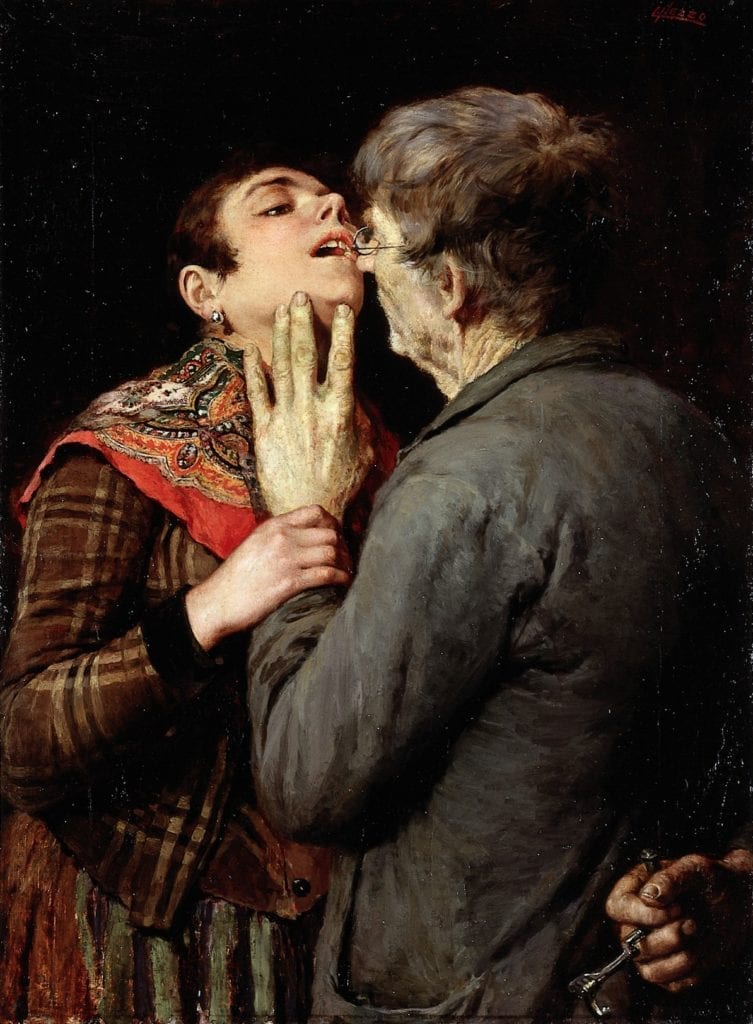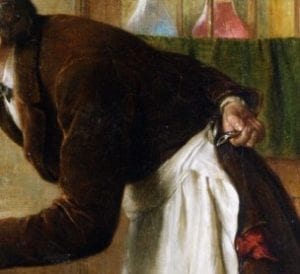Vicent Rodilla
Alicia López-Castellano
Christina Ribes-Vallés
Valencia, Spain

Dental key from the patient
by Luciano Nezzo (1856-1903).
Wellcome Collection. CC
Tooth extraction has been practiced for centuries, being carried out first by often itinerant barber-surgeons, and, once the profession became regulated in the late 1800s, by licenced dentists. Hippocrates gives one of the oldest written accounts of tooth extraction, which he considered along with cauterization to be a remedial measure for certain dental maladies.1 Hence, a variety of instruments and techniques have been developed since ancient times for this purpose.
One such instrument was the dental or tooth key, which became available in the earlier part of the eighteenth century2 as an implement used for tooth extractions and remained in use well into the twentieth century.3 Some authors have reported its successful use in Morocco as late as 1984.3 The device worked like a door key, locking a claw into the tooth to be extracted, rotating it, and loosening or breaking the tooth. Some authors have referred to the dental key as a “dangerous and barbarous instrument” since it often broke the tooth rather than loosening it, and as a result frequently produced soft tissue damage and jaw fractures.4 The dental key (also referred to as the Fothergill Key or Clef de Garengeot)2 was replaced by the modern forceps in the twentieth century. The eponym Fothergill appears to have developed from Monro’s 1742 work Medical assays and observations, in which he states he received such an instrument from a Dr. John Fothergill of London.2 René-Jacques Croissant de Garengeot (1668-1759), a French surgeon, introduced a modification to earlier keys and described it in his work Nouveau traité des instruments de Chirurgie des plus utiles.5 Earlier examples of dental keys have been illustrated by Colyer2 and others.3,5
The Italian painter Luciano Nezzo (1856-1903), best known for his history and genre subjects, illustrated a dental key in one of his paintings (Figure 1). The painting shows a young woman being examined by a barber-surgeon with ruffled hair and an unshaven appearance who is wearing a faded and scruffy coat. The woman, dressed neatly in colorful clothing, looks frightened. She is trying to hold back the operation by placing her right hand on the barber’s wrist. He is holding the instrument that terrifies her, the dental key, with his right hand and hiding it behind his back to prevent her from being frightened.

by Edward Hughes (1832-1908).
Private collection.

Edward Hughes (1832-1908). Private collection
A much older instrument eventually replaced the dental key: the forceps. James A. Taylor wrote a book on the history of dentistry in which Hippocrates is credited with the invention of an early version of a forceps as well as other dental instruments. In the same book there is an illustration of a Roman dental forceps found at the ancient Roman castle of Saalburg (Hamburg, Germany),1 which is supposed to be the oldest one in existence.3 Taylor also describes the use of forceps by the Al-Andalus surgeon Abulcasis (1050-1122) and the description and drawings of this instrument in the work of Giovanni d’Arcoli, professor at the University of Bologna. Taylor states that “the history of dental forceps and their use is as old as dentistry or surgery itself.”1 The renaissance in the use of the forceps was probably due to the newer designs introduced by Sir John Tomes during the first half of the nineteenth century.6
In a painting by the renowned English portrait painter Edward Hughes (1832-1908) an extraction forceps is shown (Fig. 2 and 3). In this painting dated 1866, a clear example of Hughes’ realistic treatment of small dramas in domestic life, a kind-looking dentist wearing an apron bends down and looks sympathetically at a worried young girl and her mother. As in the previous painting, the dentist is also hiding the tool from the patient, a common practice in the profession. The girl has placed her left hand at her jaw, obviously the place of the aching tooth while the mother is about to move her hand out of the dentist’s way. It looks like the consultation takes place in the dentist’s quarters, quite humble, judging by the ragged carpet and the chair. The mother has not removed her mantle and the daughter is still wearing her coat, implying they have just arrived. A caged bird, some flasks filled with colored liquids on the windowsill, and some scientific implements on a shelf complete the scene, adding some detail, color, and light to the subject.
As Lucio Nezzo and Edward Hughes are coetaneous artists, their two paintings illustrate the contemporary use of both instruments, the dental key (Fig. 1) and the extraction forceps (Fig. 3), during the nineteenth century.
References:
- Taylor J. History of Dentistry: A Practical Treatise for the Use of Dental Studentsand Practitioners. Lea & Febiger, Philadelphia; 1922.
- Colyer F. A note on the dental key. Proc R Soc Med. 1951;44(8):652-655.
- Kravetz RE. Tooth key. Am J Gastroenterol. 2003;98(11):2561-2562.
- Hyson JM. The dental key: a dangerous and barbarous instrument. J Hist Dent. 2005;53(3):95-96.
- Clef de Garengeot – Conservatoire du Patrimoine Hospitalier Régional. http://www.cphr.fr/conservatoire/collections/patrimoine-medical/autres-disciplines/odontologie/clef-de-garengeot/. Accessed July 15, 2019.
- Cope Z. Sir John Tomes; a great dental pioneer. Ann R Coll Surg Engl. 1957;20(1):1-12.
VICENT RODILLA, PhD, is professor of Toxicology at the Faculty of Health Sciences, Universidad CEU Cardenal Herrera in Valencia, Spain. He also teaches the history of medicine and an introduction to epidemiology to medical students. He has an interest in the visual arts and their representation of medicine.
ALICIA LÓPEZ-CASTELLANO, PhD, is professor of Pharmaceutical Technology and Medical Devices. She is Dean of the Faculty of Health Sciences, Universidad CEU Cardenal Herrera in Valencia, Spain.
CRISTINA RIBES-VALLÉS, PhD, is Assistant Dean for Dentistry at the Faculty of Health Sciences Universidad CEU Cardenal Herrera in Valencia, Spain. She teaches introduction to the dental clinic and manages the clinical training for dentistry students. She is interested in the study of the patient-doctor relationship in history and its representation in the arts.

Leave a Reply